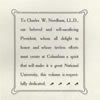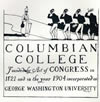George Washington University History: Overview
Introduction Credits:
Meagan Hess
Introduction Date:
04/11/2006
Introduction Text:
In 1904, the Columbian University forged a partnership with the George Washington Memorial Association and became the George Washington University. This module explores the organized effort that came to be known as The George Washington University Movement.
From Columbian College to the George Washington University
President James Monroe signed the Act of Congress that created Columbian College in Washington, D.C. on February 9, 1821. After the Civil War, the trustees moved the College from College Hill, its original location near Florida Avenue and 14th Street, to the center of Washington where the departments of law and medicine were already located. The property at College Hill was sold to provide the funds needed to construct a new physical plant. Besides being consolidated in one location, the College began to provide opportunities for employed students to take advantage of after-hours education.
By the late 1880s, the institution's charter had been amended changing the name to Columbian University, the campus was centralized in its downtown location, the University started a period of growth and expansion, adding the Corcoran Scientific School in 1888, and the School of Comparative Jurisprudence and Diplomacy in 1898. By order of the Corporation of the University at the 1892 annual meeting, a School of Graduate Studies was established, offering thirty different fields of graduate study toward the master's degree and the doctorate. The school was well along the way to its present status as an institution of higher learning closer to the center of government.
Charles Willis Needham, a Baptist layman and dean of the law school, was elected the eighth president of Columbian University in 1902. Throughout his tenure, financial difficulties plagued the institution. The University had mortgaged property to build a new medical building, which put considerable strain on finances, and for several years it operated at a deficit. President Needham had difficulty raising money to cover the losses and was looking for different directions that would help to develop and improve the University. As a result, he was open to seeking a partnership with the George Washington Memorial Association.
The GWMA, founded in 1889, was desirous of establishing in the city of Washington a national university named for the first president. George Washington had indicated in correspondence and in his Will of his desire for the establishment of a national university and had apparently suggested the Camp Hill area of Foggy Bottom as an ideal site for such a university. The Association's president, Mrs. Archibald Hopkins, influenced President Needham to propose changing the name of Columbian University to The George Washington University. In an organized effort that came to be known as The George Washington University Movement, Columbian University sold a law building and purchased Van Ness Park, immediately south of the White House, with the proceeds, agreed to change its name, revised its emphasis toward more post-graduate education, and declared itself nondenominational. The name of the University was officially changed by Act of Congress on January 23, 1904 and by the Board of Trustees on February 20.
As a part of the negotiations, the University trustees asked the Memorial Association to construct on University property, at a cost of $500,000, a building dedicated to the memory of George Washington. The University would use the building for administration, graduate works, lectures and research, and meeting space for learned societies. The Association agreed to raise funds for the building through subscription and gifts. Upon completion, the George Washington Memorial building was to belong to and be maintained by The George Washington University.
A competition for the design of the building was announced and a jury selected. The winner of the contest was by a local firm, Hornblower and Marshall, and shows the concept for the building and quadrangle. The print appeared in Harper's Weekly and was circulated, presumably, in the fundraising effort.
During the same period, the University was in an aggressive period of expansion. It acquired the National College of Pharmacy, organized a College of Veterinary Medicine, and created the College of Engineering and Mechanical Arts. This expansion, combined with the costs of construction and maintenance, created a heavy economic burden.
The Memorial Association, in the meantime, was having difficulty raising capital for the Memorial Building, which seemingly would have come as a shock, because, as it was said in the 1904 University Bulletin,
We can but believe, therefore, that there will be a most generous response to the appeal for the establishment of this University, bearing this illustrious name, situated and organized to secure these results, and securing, through the distribution of its students over the entire country, that “more perfect union” so much desired by Washington and by all patriotic men and women throughout the land.
In fact, much of the fund-raising literature appealed to subscribers' sense of patriotism and nationalism. Even when fundraising efforts were combined under the control of the University's Board of Trustees, subscriptions were not forthcoming. Finally, President Needham was forced to sell some of the University's valuable property to cover the losses, and one of the parcels sold was the five acre plot just south of the White House where the Memorial Building had been planned. The Memorial Association withdrew from its agreement with the University in 1909.
While this chapter in the University's history seems to have been fruitless, it did provide the University with its current and important name. Under a new president, Charles H. Stockton, who was elected in 1910, the financial picture began to improve. Stockton reorganized the University, sold most of its property and relocated the department of arts and sciences to 2023 G. Street... in Foggy Bottom, the area that George Washington himself had envisioned as the site for a national university. Ironically, after nearly a century, the University was finally named for him and located in the place he had selected.

Document List
 | Excerpt from George Washington's Will (07/09/1799) This excerpt is from the oft-cited portion of George Washington's will where he expresses his desires for the creation of a national university and bequeaths "the fifty shares which I hold in the Potomac Company... towards the endowment of a UNIVERSITY to be established within the limits of the District of Columbia." |
 | Will Not Be Disbanded (10/31/1903) An October 31, 1903 article from The Washington Post that details a meeting of the George Washington Memorial Association where its members decided to continue the association. Columbian University President Charles Needham was present at the meeting to propose a partnership between the University and the Association. |
 | Columbian University Seal (00/00/1904) The Columbian University seal From the Cherry Tree (student yearbook) from 1904. |
 | Dedication to President Needham (00/00/1904) A dedication to University President Charles Needham in the Cherry Tree (student yearbook), 1904. |
 | Van Ness Park, c. 1904 (00/00/1904) A photograph of Van Ness Park and mansion from the 1904 Cherry Tree (student yearbook). |
 | Memorial Hall Blueprint (00/00/1904) The first floor plan for Memorial Hall from the 1904 Cherry Tree. |
 | Time to Quit (00/00/1904) A cartoon from the final page of the 1904 Cherry Tree (student yearbook), that says "Time to Quit." |
 | History of Columbian College Cartoon (00/00/1904) A cartoon that notes the founding year of Columbian University and the year that it was incorporated into George Washington University. From The Cherry Tree (student yearbook), 1904. |
 | February 20, 1904 Columbian University Board of Trustees Meeting Minutes (02/20/1904) At this meeting of the Board of Trustees, University President Charles Needham presented a letter from Mrs. Archibal Hopkins, President of the George Washington Memorial Association that discusses a partnership between the Association and the University. |
 | Giant Strides of Progress at Columbian (03/02/1904) A short blurb from the March 2, 1904 The Columbian Weekly, the student newspaper that informs readers, "events of the greatest importance are taking place at Columbian," including the construction of new buildings. |
 | May 2, 1904 Columbian University Board of Trustees Minutes (05/02/1904) At this meeting of the Board of Trustees, University President Charles Needham submitted the resolutions adopted by the Executive Committee of the George Washington Memorial Association. Detailed are the provisions for the building of the George Washington Memorial Building and the changing of the University name to the George Washington University. |
 | Map showing the location of the proposed University expansion. (06/00/1904) This map displays the proposed sites for future University buildings, emphasizing the University's closeness to the center of Washington, D.C. and its government buildings. |
 | Design for new University Buildings (06/00/1904) This "tentative plan of a group of buildings on new site," is an artist's rendering from the University Bulletin of 1904. |
 | Explanation of the University name change for Columbian Alumni (06/00/1904) The 1904 Columbian University bulletin, Alumni Number, explains the reasoning behind the partnership with the George Washington Memorial Association and examines George Washington's desires for a national university. |
 | No Right to the Name (06/27/1904) A June 27, 1904 article from The Washington Post that details the protest of John W. Hoyt, Chairman of the National University Committee to the changing of Columbian University's name to the George Washington University. Hoyt explains that talks were in progress to create a "true" national university and he resents Columbian's actions, accusing them of personal selfishness and local ambition, and calls the University unworthy of Washington's name. |
 | November 16, 1904 Columbian University Board of Trustees Meeting Minutes (11/16/1904) At this meeting of the Board of Trustees, members discussed the architectural competition to design the new University buildings at Van Ness Park and the new University seal and colors were also voted upon. |
 | Plans for the new George Washington University (12/31/1904) Drawing of the proposed plan for the new buildings of George Washington University, published in Harper's Weekly, on December 31, 1904. |
 | The George Washington University Seal (00/00/1906) The seal for the new George Washington University. It was decided that the seal colors would be the buff and blue of George Washington's uniform that was held in the National Gallery. |
 | Plans for the new building at Van Ness Park (00/00/1906) A drawing of the proposed plan for the George Washington Memorial Building at Van Ness Park. |
 | Washington's Tomb at Mount Vernon (00/00/1906) A photograph from the 1906 Cherry Tree (student yearbook) that shows George Washington's Tomb at Mount Vernon. |
 | Letter for the "Campaign to Raise $400,000 in the City of Washington (00/00/1907) A campaign letter for the 1907 "George Washington University Movement," asking people to become "charter members of the Site Fund." |
 | Building Fund Donation Form (00/00/1907) This form, part of the "George Washington University Movement," asks the potential subscriber to "kindly fill out and tear off" the form in order to pledge their donation, to be made in "five equal installments," beginning on July 1, 1907. |
 | Fundraising Letter Directed at Women (03/00/1907) This fundraising letter, part of the "George Washington University Movement" of 1907, is addressed to "My Dear Madam" and invites "public-spirited" women to donate to the building fund of the University. |
 | Letter from Theodore Roosevelt (03/15/1907) A congratulatory letter from Theodore Roosevelt, addressed to Columbian University President Charles Needham. |
 | April 17, 1909 Columbian University Board of Trustees Meeting Minutes (04/17/1909) At this meeting of the Board of Trustees, a letter was read from Susan Whitely Dimock, detailing the George Washington Memorial Association's decision to dissolve their partnership with the University after the sale of the property at Van Ness Park. |
